
Try-It Diet: Lactose-Free
A two-week healthy eating plan
Adams Media, an imprint of Simon & Schuster, Inc.

Avon, Massachusetts
Contents
Introduction
A Try-It Diet is just that a diet that you can try out for two weeks to see if it is a good fit for you. Keep in mind that not every diet is right for every person; please consult with your doctor before making radical changes to your diet. Lactose intolerance (LI) doesnt necessarily mean you cant have any foods with lactose in them, but there are certain foods you will want to avoid. For every high-lactose ingredient you need to cut from your diet, there are half a dozen tasty alternatives for you to enjoy. Look at your LI lifestyle as a challenge to sniff out the tastiest, healthiest foods. Many individuals are living in unnecessary discomfort, and simple diet changes could easily make a huge difference.
There is no magic wand to cure LI and no medical procedure that will correct it. Your comfort zone in living with LI depends on what you put in your mouth. Lactose is a primary simple sugar found in milk and dairy. In order to digest lactose, the digestive enzyme lactase must be present in the small intestine. Lactase breaks down the milk sugar into two simpler forms of sugar, glucose and galactose, which allows absorption into the bloodstream. If theres a shortage of lactase in the small intestine, lactose carries additional fluid as it moves down to the colon.
Fermentation of lactose in the colon begins to take place, and gases form. (Think of the fermentation process of fine wines and champagne.) The gas bubbles can be very uncomfortable, causing gastrointestinal symptoms such as cramping, flatulence, nausea, diarrhea, and abdominal bloating. Symptoms can range from severe pain to mild discomfort, depending on each individuals degree of lactase deficiency and the amount of lactose thats been consumed. Its common for symptoms to begin anywhere from thirty minutes to three hours after eating or drinking food containing lactose. A major key to your digestive comfort is being food label savvy. Read labels and look for the obvious lactose first.
Naturally occurring lactose in milk is listed as sugar on the Nutrition Facts label on a milk carton but the ingredients section doesnt list any added sugar. Its important to look not only for milk and lactose among the contents, but also for such terms as whey, curds, buttermilk, malted milk, milk by-products, dry milk solids, nonfat dry milk powder, sour cream, and sweet cream, all of which contain lactose. It doesnt have to be in the dairy section to contain lactose. Every product and brand varies. Just because you become accustomed to a particular brand you think is free of lactose, be sure to read the label periodically because ingredients do change. It just so happens that many of the foods LI individuals shy away from are prime sources of calcium, so keeping calcium in the diet is a primary concern for people with LI.
Calcium is the primary mineral for the growth, maintenance, and repair of bones and teeth. Calcium needs to be teamed with vitamin D and phosphorus for maximum benefits. Phosphorus is important to bone structure, and vitamin D allows the absorption of calcium into the body. Its possible to have a calcium deficiency due to a lack of vitamin D; even if you are taking in enough calcium, your body cant do anything with it unless it has vitamin D. Theres a wide array of calcium-rich foods for you to choose from. Heres a short list of foods that will help you make sure youre meeting your daily calcium quota: kale, whole almonds, shrimp, soybeans, beans, extra firm tofu, yogurt.
Yes, yogurt is made from milk, but you may be delighted to know that it fits in with your LI lifestyle. Enter stage left the culturing process that milk goes through to become yogurt. Its this process that allows most lactose intolerant folks to enjoy yogurts nutritional benefits and satisfying taste. Including cheese in your LI lifestyle depends on two things: the kinds of cheese you eat and the amount. Start out small and see what your level of tolerance is. Read labels.
Youll find the lactose content in cheeses under sugar; the milk sugar in cheese is lactose. The standards on the Nutrition Facts label allow the cheese maker to list zero grams of sugar in cheese if the cheese contains no more than half a gram of lactose per ounce. There are cheeses available to you with just trace amounts of lactose and even more with low levels of lactose (12 grams or less per serving). Many lactose intolerant people are able to digest aged, natural cheeses. Please feel comfortable to substitute ingredients in the recipes in this book. Some lactose intolerant folks can tolerate butter, for instance.
If you like the taste of rice milk and dont like the taste of soy milk, so what? Its your culinary creation; use rice milk or other nondairy alternatives that appeal to you! Use the recipes here as basic recipes. Once you get the hang of discovering where lactose lurks and pinpoint your own personal tolerances, youre armed and ready to adjust your favorite recipes to keep your stomach and your taste buds happy. If youd like to explore the lactose-free cooking in more detail, check out The Everything Lactose-Free Cookbook , available in print (ISBN: 978-1-59869-509-0) and eBook (eISBN: 978-1-60550-209-0) formats.
Weekly Meal Plans
Week 1
Sunday
Breakfast
Lunch
Dinner
Dessert
Monday
Breakfast
Lunch
Snack
Dinner
Tuesday
Breakfast
Lunch
Snack
Dinner
Wednesday
Breakfast
Lunch
Snack
Dinner
Thursday
Breakfast
Lunch
Snack
Dinner
Friday
Breakfast
Lunch
Snack
Dinner
Saturday
Breakfast
Lunch
Dinner
Dessert
Week 2
Sunday
Breakfast
Lunch
Dinner
Dessert
Monday
Breakfast
Lunch
Snack
Dinner
Tuesday
Breakfast
Lunch
Snack
Dinner
Wednesday
Breakfast
Lunch
Snack
Dinner
Thursday
Breakfast
Lunch
Snack
Dinner
Friday
Breakfast
Lunch
Snack
Dinner
Saturday
Breakfast
Lunch
Dinner
Dessert
Strawberry Banana French Toast This is a show-stopper for a Sunday brunch and pretty enough to be a dessert! Serves 1
 Next page
Next page
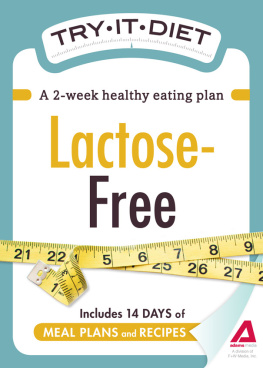

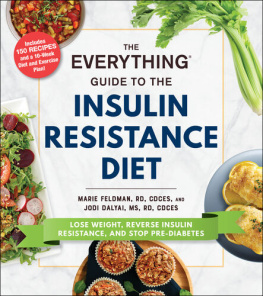
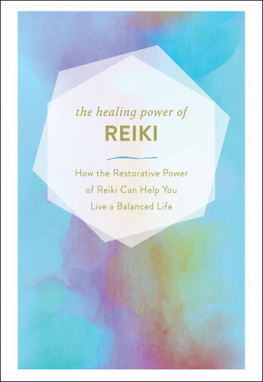

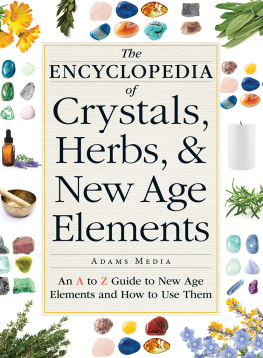
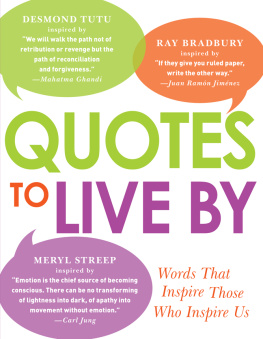
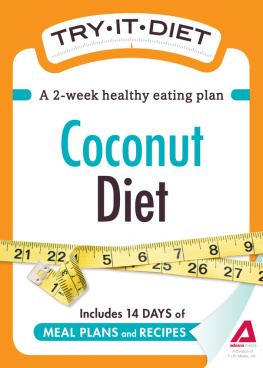
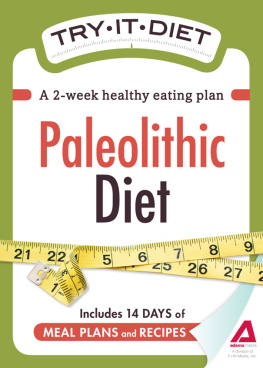

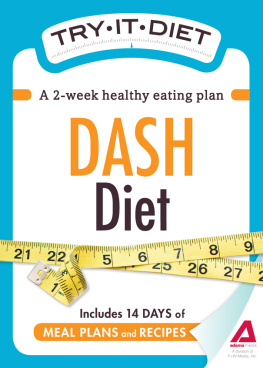
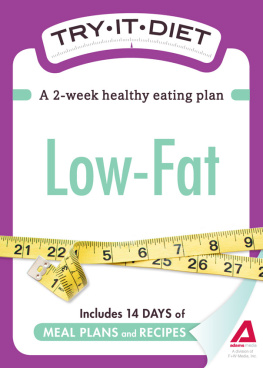
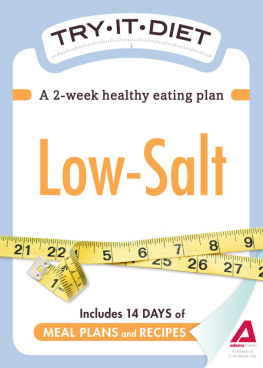

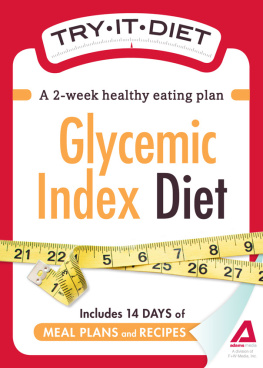


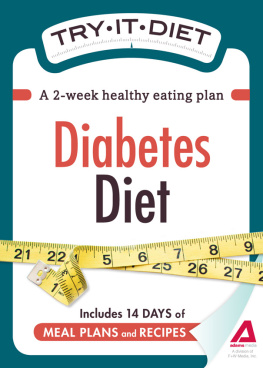
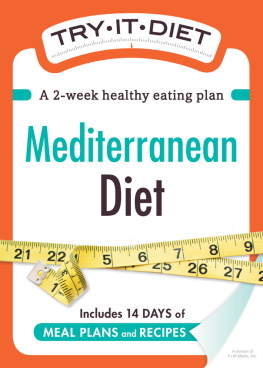

 Avon, Massachusetts
Avon, Massachusetts 